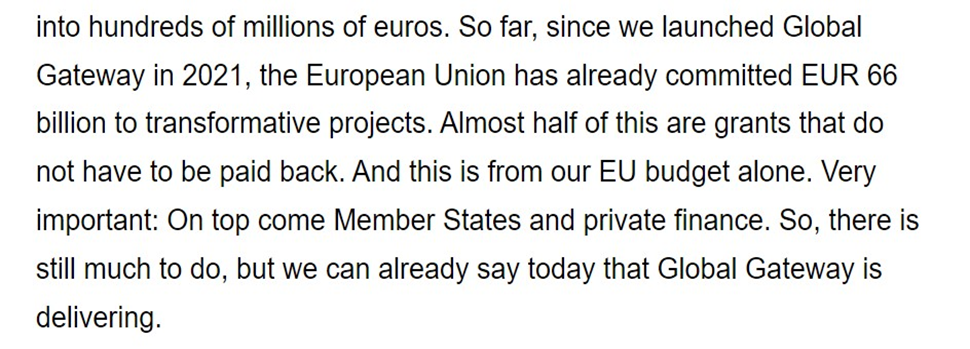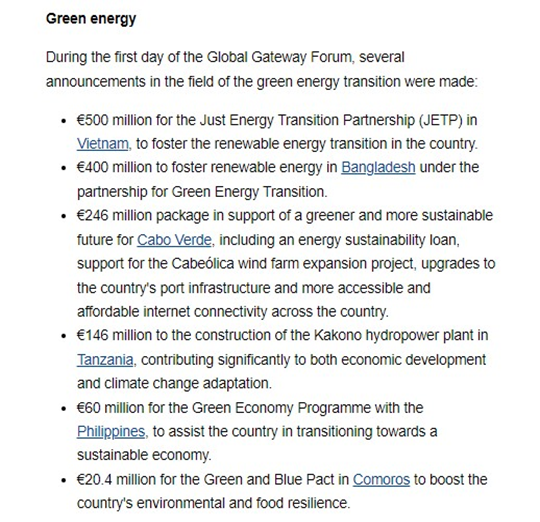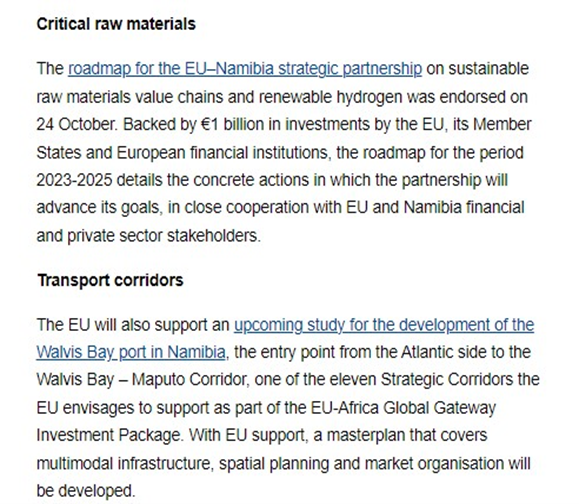Rival contenders to China’s Belt and Road Initiative (BRI) are in a precarious position, struggling to catch up with delayed alternative strategies.
October 2023 offered a critical insight into the ongoing global competition for influence via connectivity and infrastructure expansion in emerging economies, featuring the major actors: China, the U.S. (backed by the G7), and the EU.
On the BRI’s 10th anniversary, China has shifted focus. Originally rooted in providing overseas loans for infrastructure development and economic connectivity as a formidable foreign policy tool, the BRI is now evolving into a proactive force seeking to influence and shape global rules and structures.
China claims to have galvanized US$1 trillion in global investments and executed over 3,000 projects generating 420,000 jobs across 149 out of 194 countries worldwide. It has evolved into a versatile tool for bolstering both soft and hard power, although China primarily highlights its “soft connectivity” aspect.
However, China now intends to achieve broader geopolitical goals, encompassing a wider range of political and security dimensions as part of a strategy to increase global influence in opposition to Western-centric approaches. The BRI is harnessed to forge strategic alliances, extend China’s global footprint, and shape international politics and dynamics, especially within the so-called ‘Global South.’
Realizing China’s potential to exert substantial influence by meeting the infrastructure needs of developing economies, the EU and U.S. presented respectively the Global Gateway (GG) in December 2021 and the Partnership for Global Infrastructure and Investment (PGII) in June 2022.
Is the Global Gateway a Genuine Geopolitical Initiative?
The European Commission (EC) approved the GG, aiming to mobilize up to €300 billion (US$322 billion) by 2027 through a combination of public and private funds. Unlike China’s lending approach, it prioritizes demand-driven investments.
The first GG Forum was held on October 25, 2023, two years after its launch. An opportune moment to translate the essence of a “project without plan” into clear and tangible terms, enlightening about authentic purpose and objectives.
Surprisingly, the EC President revealed that, in its second year, the initiative to “create links and not dependencies” had amassed €66 billion (US$71 billion) for “transformative projects” (Figure 1), although details on the allocation and sources of this sum remain opaque.

Figure 1. Source: Opening speech by Von der Leyen, Global Gateway Forum. Brussels, October 25, 2023:
https://ec.europa.eu/commission/presscorner/detail/en/speech_23_5305
Essentially, Von der Leyen explicitly detailed only €2.5 billion. The projects have shifted towards green transition, critical raw materials, transport corridors, and education programs in Africa, Asia, the Balkans, and the Caucasus, increasing development aid and reducing strategic geopolitical expenditure. Notably, the EU–Namibia partnership on sustainable raw materials leads with €1 billion, while other green projects include €500 million in Vietnam or €400 million in Bangladesh (Figure 2).
 |
 |
Figure 2. Source: Press release, Global Gateway Forum, Brussels, October 25, 2023:
https://ec.europa.eu/commission/presscorner/detail/en/ip_23_5199
The information becomes increasingly perplexing as the EC’s website indicates that GG has invested “€150 billion” for the Africa-Europe Investment Package and additional “€45 billion” in Asia, LATAM and the Caribbean (Figure 3). If these numbers were accurate, the EC would have secured two-thirds of the €300 billion, representing a remarkable 65% of the total commitment. A noteworthy achievement when contrasted with the GG’s inaugural year, when it reported investments of €16.4 billion, representing 5.5% of the overall commitment.

Figure 3. Source: Official website of Global Gateway on the EC site. Accessed on October 25, 2023:
https://commission.europa.eu/strategy-and-policy/priorities-2019-2024/stronger-europe-world/global-gateway_en
The conflicting data underscores the persistent enigma surrounding the GG, which seems to be a marketing-oriented facade encompassing all EU development initiatives, prompting questions about its purported geopolitical purpose.
Additionally, despite the 27 member states expected to participate under the “Team Europe” partnerships, uncertain contributions and involvement raise transparency and progress concerns. Clarifying member states’ roles is essential for the initiative’s effectiveness and accountability.
The (Apparent) Competitive Challenge
Major powers are engaged in fierce geo-economic competition, vying for advantages through foreign infrastructure expansion, investments, loans, contracts, market enlargement, and optimized supply chains—each framed as endeavors for global development and prosperity.
Three key issues surface as Western alternatives to the BRI strive to gain momentum.
Firstly, the West endeavors to establish a distinctive position by emphasizing “values.” However, this reference might appear peculiar to developing countries that require tangible investments. In geopolitics, especially concerning infrastructure strategic investment, practicality outweighs values and ideology. Thus, this message seems tailored for domestic audiences to distinguish these investments from what may be perceived as ‘less reputable’ Chinese initiatives. Ultimately, the true significance of infrastructure lies in its actual completion, both for donors and recipients.
Conversely, China’s readiness to embrace risks and invest when others hesitated reveals a bold approach to economic and strategic ventures, underscoring Beijing’s ambition, forward-thinking, and proactive stance, which have ultimately yielded success. This challenges the previous argument regarding the primacy of “values” in these pursuits, as China’s pragmatic and proactive actions clearly wield significant influence.
Then again, the West is striving to enhance the appeal of their initiatives compared to the BRI. The primary driver of their potential success lies in a negative aspect: BRI has raised significant apprehension about the debt and dependency experienced by countries struggling to repay loans (Argentina, Ethiopia, Kenya, Malaysia, Montenegro, Pakistan, Sri Lanka, Tanzania, Zambia), a worrisome phenomenon dubbed as “debt trap diplomacy.”
Besides, a few main differences set the BRI and GG/PGII initiatives apart.
They exhibit contrasting dynamics in project initiation, funding, development, and geopolitical objectives. The EU’s strategy favors a market-driven model, where the private sector leads in project direction and financing. It prioritizes profitability, capital returns, economic growth, and strategic viability while addressing the development needs of participating nations.
In stark contrast, the BRI features a more dominant role of the Chinese government in terms of funding, control, and oversight. BRI commences with government-to-government negotiations, prioritizing strategic development requirements, project viability and geopolitical objectives over immediate profitability. It adopts a strategic approach, forging diplomatic ties, interwoven with long-term economic interests.
Furthermore, China’s project management efficiency differs significantly from Western counterparts, which involve complex regulatory frameworks, strict standards, lengthy contracting processes with bids and tenders, and financial constraints, making them more intricate. Contrariwise, China offers a streamlined process. Western systems include democratic oversight with checks and balances, differing from China’s more direct approach, enabling officials to engage with governments, expedite project selection, identify suitable companies, and secure financing from state banks.
China’s BRI Dominance vs. EU’s Global Gateway Ambiguity
The diverse strategies and varying stages of development have yet to show signs of there being a clear victor. Notably, BRI’s decade-long head start places it in a pivotal position, shaping the years ahead. China has emerged as the top bilateral creditor, often becoming the primary trade partner of its borrowing nations, cementing global influence.
Over the past decade, remarkable accomplishments like the China-Pakistan Economic Corridor, China-Brazil Fund, and various port and railway projects–especially the ‘String of Pearls’ strategy- have left lasting global impact. These endeavors align with strategic theories like Mackinder and Spykman, highlighting the significance of controlling Eurasia and coastal regions for global supremacy. China’s expertise in cyberspace – where current and future struggles for dominance are already taking place - further accentuates its quest for digital hegemony in shaping the world.
While EU institutions assert that the GG is advancing, there remains uncertainty concerning its political direction due to the real level of commitment, specific figures, and implementation procedures. Additionally, it is unclear whether the GG aims to provide development assistance or is geared towards making geopolitical infrastructure investments.
In a nutshell, the GG’s trajectory is poised to mark von der Leyen’s most significant political and managerial failure. The formidable competition posed by the well-established BRI has been inadequately addressed or mitigated. To catch up, the EU should emphasize meticulous project planning, synchronize with broader foreign policy goals, and adapt quickly to evolving geopolitical dynamics. Linking trade and investment to political objectives can enhance influence. A realpolitik approach, driven by pragmatism and core interests, is essential for long-term geopolitical prowess. This multifaceted strategy is crucial for the EU’s quest for global influence and effective competition.
